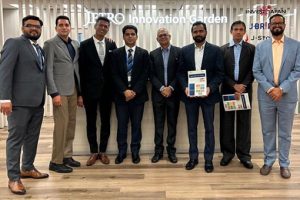The United States and Singapore recognize the immense potential of critical and emerging technologies to drive inclusive economic growth, reshape societies, and impact the global geopolitical landscape. In light of this, and building on the commitments made during the March 2022 meeting between U.S. President Joseph R. Biden, Jr. and Prime Minister Lee Hsien Loong of Singapore, the two nations are committed to advancing their partnership. They aim to cultivate open, accessible, and secure technology ecosystems rooted in mutual trust, adherence to the rules-based international order, and a shared vision for the future.
Strategic Partnership and Climate Commitment:
Deputy Prime Minister Lawrence Wong of Singapore opened the inaugural U.S.-Singapore Critical and Emerging Technology (CET) Dialogue in Washington, D.C., which was chaired by National Security Advisor Jake Sullivan, Acting Special Envoy for Critical and Emerging Technology Seth Center, Minister for Foreign Affairs Dr. Vivian Balakrishnan, and Minister for Communications and Information Josephine Teo. The U.S. and Singapore pledge to elevate their bilateral partnership to continue their collaborative endeavors at the forefront of scientific and technological progress, all for the benefit of their citizens and partners in ASEAN and the Indo-Pacific region.
This includes their ongoing work in addressing the climate crisis through the U.S.-Singapore Climate Partnership, which focuses on innovation in low- and zero-emission technologies. This partnership, established in 2021 and updated in 2023, seeks to drive efforts in decarbonization and renewable energy deployment, particularly in sectors like shipping and aviation.
Avenues for Collaboration:
The U.S.-Singapore CET Dialogue serves as the first step in building enduring collaboration across various sectors, including business, science, and national security. The goal is to deliver tangible benefits to the people of both countries and their partners in the region. They will enhance scientific and research ties across governments, industries, and universities with a commitment to the timely exchange of knowledge, scientific rigor, and quality. Additionally, the two nations are exploring the possibility of a bilateral agreement to expand their science and technology cooperation.
This high-level forum will complement existing bilateral initiatives like the U.S.-Singapore Partnership for Growth and Innovation and the U.S.-Singapore Cyber Dialogue. It will support their joint participation in multilateral economic efforts, including the Indo-Pacific Economic Framework for Prosperity (IPEF), which aims to bolster two-way trade, resilient supply chains, the transition to clean energy, anti-corruption measures, and the efficiency of tax administration.
Six Key Areas of Focus:
The U.S. and Singapore intend to anchor the CET Dialogue in six main areas, each of which significantly impacts their shared security and prosperity:
- Artificial Intelligence (AI): Both nations plan to deepen information-sharing and consultations on international AI security, safety, trust, and standards development. They aim to launch a bilateral AI Governance Group to advance shared principles and information exchanges for responsible AI innovation. Collaboration will extend to AI safety, security, and workforce development.
- Digital Economy and Data Governance: The U.S. and Singapore will work together to promote inclusive and sustainable economic growth by developing a bilateral Roadmap for Digital Economic Cooperation. This roadmap will address issues like data governance, digital standards, digital inclusion, consumer protection, and opportunities for small- and medium-sized enterprises in the digital economy.
- Biotechnology: Both nations emphasize the importance of building secure and ethical standards around DNA sequencing data, storage, and research. They aim to advance research and development in areas like synthetic biology, cell and gene therapeutics, and genetic delivery systems.
- Critical Infrastructure and Technology Supply Chains: The U.S. and Singapore commit to promoting secure and resilient information and communications technology infrastructure. They plan to deepen knowledge-sharing on smart cities, with a focus on climate resilience, and establish a Smart Cities Program on AI. They also intend to exchange information on domestic strategies for strengthening semiconductor supply chain resilience.
- Defense Innovation: The U.S. Department of Defense and the Singapore Ministry of Defence will expand collaboration on critical emerging technologies and defense innovation. This partnership will integrate commercial and dual-use technologies to address operational challenges for their militaries.
- Quantum Information Science and Technology: Both nations will support each other’s investments in national quantum information sciences initiatives. They aim to expand engagement and talent exchanges, coordinate on standards, and share information on Post Quantum Cryptography migration.
A Brighter Future:
The United States and Singapore will engage in close consultations to build a robust innovation ecosystem. Their goal is to ensure that emerging technologies enhance their shared security and prosperity. They will utilize the CET Dialogue to facilitate candid and ongoing exchanges regarding risks, opportunities, and national security implications associated with technological advancements.
The two nations look forward to the next CET Dialogue in Singapore in 2024 and will coordinate with relevant ministries, departments, and agencies, as well as external stakeholders, to advance their shared goals. Their commitment to excellence, adherence to international law, sovereignty, and peaceful dispute resolution will underpin their enduring partnership as they work together to shape a brighter future for their citizens and the broader Indo-Pacific region.






















